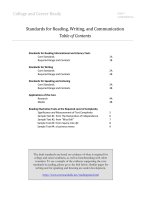LIBRARIAN’S HANDBOOK FOR SEEKING, WRITING, AND MANAGING GRANTS ppt
Bạn đang xem bản rút gọn của tài liệu. Xem và tải ngay bản đầy đủ của tài liệu tại đây (1.39 MB, 332 trang )
LIBRARIAN’S HANDBOOK FOR
SEEKING, WRITING, AND
MANAGING GRANTS
This page intentionally left blank
LIBRARIAN’S
HANDBOOK FOR
SEEKING, WRITING,
AND MANAGING
GRANTS
Sylvia D. Hall-Ellis,
Stacey L. Bowers,
Christopher Hudson,
Claire Williamson, and
Joanne Patrick
Copyright 2011 by Sylvia D. Hall-Ellis, Stacey L. Bowers, Christopher Hudson, Claire W illiamson,
and Joanne Patrick
All rights reserved. No part of this publication may be reproduced, stored in a retrieval
system, or transmitted, in any form or by any means, electronic, mechanical,
photocopying, recording, or otherwise, except for the inclusion of brief quotations in a
review or reproducibles, which may be copied for classroom and educational programs
only, without prior permission in writing from the publisher.
Library of Congress Cataloging-in-Publication Data
Librarian’s handbook for seeking, writing, and managing grants / Sylvia D. Hall-Ellis [et al.].
p. cm.
Includes bibliographical references and index.
ISBN 978–1–59158–870–2 (hard copy : alk. paper) – ISBN 978–1–59158–872–6 (ebook)
1. Project management—Finance. 2. Project management—Evaluation. 3. Education—
Research—Finance. 4. Proposal writing for grants. I. Hall-Ellis, Sylvia D.
HD69.P75L533 2011
025.1
0
1–dc22 2011005085
ISBN: 978–1–59158–870–2
EISBN: 978–1–59158–872–6
15 14 13 12 11 1 2 3 4 5
This book is also available on the World Wide Web as an eBook.
Visit www.abc-clio.com for details.
Libraries Unlimited
An Imprint of ABC-CLIO, LLC
ABC-CLIO, LLC
130 Cremona Drive, P.O. Box 1911
Santa Barbara, California 93116-1911
This book is printed on acid-free paper
Manufactured in the United States of America
Excerpts from Grants for School Libraries by Sylvia D. Hall-Ellis and Ann Jerabek.
Copyright # 2003 by Sylvia D. Hall-Ellis and Ann Jerabek. Reproduced with permission
of ABC-CLIO, LLC.
CONTENTS
Preface xi
Introduction xv
Part 1: Grant Development 1
1 Planning: The Core of Proposal Development 3
Planning Defined 5
The Rationale for Planning 6
Readiness for Planning 7
Historical Commitment to Planning 10
The Reward System for Staff Contributions 10
Culture and Complexity of the Organization 11
Rate of Growth 12
Financial Resources 14
Ready Reference Handbooks and Tools 14
Access and Availability of Information 15
Willingness to Take Risks 16
General Guidelines for the Predevelopment Planning Process 16
Calculating the Funding Potential 18
Managing Proposal Development 19
Selecting Partner Organizations 19
Calendar Development 28
Planning Meetings 33
Initial Planning Meeting 34
Conceptual Design Meeting 35
Working Meetings 35
Decisions Relating to Proposal Preparation 35
Writing and Editing Issues 37
Document Formatting Issues 39
2 Project Design 41
Needs Statement 42
Context of the Problem 43
Justification for the Project 44
Aspect to be Addressed 44
The Importance of a Lucid Mission Statement 44
Project Goal Development 45
The Relationship of the Goal and Objectives 47
Conceptual Design of the Project 50
Preliminary Checklists 50
Methodologies 50
The Dynamic Process Underlying Project Design 53
Laying the Groundwork for a Collaborative Effort 53
Steps to Prepare the Project Design 54
Project Management 58
Establishing an Advisory Group 59
Orientation for the Advisory Group 60
Parental Involvement with the Project 60
3 Project Narrative 65
Proposal Functions 66
Components of the Proposal 67
Cover Sheet (Face Sheet) 70
Abstract 70
Table of Contents 71
Introduction 71
Needs Assessment 71
Goals, Objectives, and Activities 72
Service Programs 74
Evaluation Design and Research Implications 75
Dissemination of Findings, Res ults, and Products 77
Plan for Continued Support (Sustainability) 78
Budget 78
Appendices 80
Letter of Transmittal 80
Proposal Writing, Design, and Organizational Guidelines 81
4 Project Personnel 85
Project Staffing Requirements 85
Requirements from the Funding Agency 87
Requirements from the Applicant 90
vi Contents
Capabilities Statements for Key Project Personnel 90
Principal Investigator (or Project Director) 93
Support Staff 94
Local Personnel Available to the Project 94
Library Administrators 94
Librarians in Public Library and Academic Library Settings 97
School Librarians 98
Instructional Personnel 98
Parents 99
5 Project Evaluation 101
Overview of the Evaluation Process 102
Evaluation Methods 102
Formative Evaluation 103
Summative Evaluation 104
The Basics of Evaluation 106
Selecting an Evaluator 127
Internal Evaluation Teams 127
External Evaluation Teams 132
Planning the Evaluation 132
Analyzing Evaluation Data 136
Writing the Evaluation Report 137
Executive Summary 137
Formative Evaluation 137
Summative Evaluation 138
6 Budget Development 141
The Role of the Budget 142
Budget Preparation 143
Ground Rules for Budget Preparation 144
Identify the Costs 145
Drafting the Budget 147
Reviewing the Budget 163
Additional Budgeting Considerations 163
The Influence of Funding Agencies on Budget Formatting 163
Budget Adjustments and Amendments 164
Subcontracts 164
7 Appendices 167
The Roles of Appendices 167
Grant Compliances and Assurances 168
Demographic Data and Community Descriptions 170
Profiles of Participating Institutions 170
Curriculum Vitae and Job Descriptions 170
Standards, Benchmarks, and Academic Achievement 173
Contents vii
Literature Review, “Best Practices,” and Models 173
Letters of Commitment and Letters of Support 179
Bibliography of Resources Consulted 180
Part 2: Implementation and Management 183
8 After the Proposal 185
Activities Between the Submission and Decision 186
Strategies for Successful Grant Recipients 187
Strategies for Organizations Failing to Obtain Grant Funding 189
Poor Grantmanship Practices 190
The Narrative 190
The Budget 191
The Details 192
Resubmitting the Proposal 193
9 Implementing the Project 195
Getting Started: Celebrate, Praise, and Communicate 195
Notifying Partners 197
Accepting the Award 199
Review Project Award Information and Documents
Provided by the Grantor 200
The Project Handoff 200
Acceptance Paperwork 201
Internal Accounts and Fiscal Paperwork 201
Staffing and Training 201
Hiring Project Personnel 204
Employees, Consultants, and Vol unteers 207
Developing Position Descriptions 209
Advertising the Position 211
The Interview Process 213
Developing Interview Questions 214
After the Hiring Decision Is Made 217
Setting Up the Project Office 218
Announcing the Grant Award 219
Internal Promotion of the Grant Award 219
Traditional Ways of Promoting the Grant Project 219
Web Sites and Other Electronic Publications 220
Online Surveys 220
Promoting the Grant Project Using Social Media 221
Building an Online Community to Support the Grant Project 222
Overlooked Opportunities to Promote the Grant Project 222
10 Managing the Project Day-to-Day 225
Organizational Structure: The Big Picture 225
Roles and Responsibilities: The Details 227
viii Contents
Operations 230
Managing People 231
Management Styles 231
Leadership and Team Building 234
Deadlines, Calendars, and Timelines 235
Planning for the Unexpected 249
11 Project Accountability 253
Fiscal Management 254
Accounting and Financial Management 255
Budget Modifications 260
Cost Share 262
Legal Overview and Issues 267
Components of a Contract 269
Contract Terms and Their Importance 270
General Contract Tips 272
Grants versus Contracts 272
Specific Types of Agreements in the Grant Context 273
Project Evaluation 282
Conducting Evaluations 283
Writing Project Reports 284
Deliverables 286
12 Project Closeout 289
Glossary of Grant Terms 291
Bibliography 299
Index 305
Contents ix
This page intentionally left blank
PREFACE
Success in writing and winning grants comes through pr actice-based effort,
sustained enthusiasm, tenacity, and a commitment to turn temporary set-
backs (i.e., proposal rejections) into renewed efforts and grant awards.
Few educators or librarians begin their professional careers prepared to par-
ticipate in the grant seeking process. As their careers evolve, they recognize
and understand economic realities. Without supplemental funding, schools
and their media centers are often forced to choose between essential and
desirable programs. Consequently, the importance of identifying and secur-
ing supplemental financial resources increases as tax revenues, formula-
driven state support, and mandated monies decrease. Challenged to pay
for a portion of programs and services with non-institutional funds, includ-
ing their own paychecks, educators and media specialists seek supplemental
funding. Their dedication to students’ academic and personal successes fre-
quently drives them to investigate the grant-making process. This interest
may begin during professional develop ment sessions, conferences, or site-
based committee work. Or interest can begin in response to an administra-
tor’s decision to seek additional funds.
Larger public, academic, and specialized libraries have historically par-
ticipated in the writing and winning of grants. However, as school media
centers increase institutional participation in the grant arena, staff pr edict-
ably lack resources and expertise required to compete with their larger col-
leagues. Novice grant writers seek opportunities to gain knowledge about
funding and grantors, “best practices” research, and writing skills. They
need encouragement to manage proposal development, project design,
evaluation techniques, and articulate collaborative arrangements among
partner organizations.
Inexperienced grant writers are likely to find the process confusing, time-
consuming, and intimidating. We have made significant efforts to cover the
full spectrum of the process in a lucid, succinct format. In short, this book is
designed to provide the information necessary for educators and media spe-
cialists to become effective members of grant development teams.
This book is a desktop, ready-reference handbook. The text may be used
for casual inquiry or as a guide during grant writing. Its scope embraces all
aspects of the proposal development process and the requirements for grant
management regardless of the size of library or level of K-12 education.
Teachers, elementary and secondary education administrators, librarians,
library coordinators, and others involved in the “community of learners”
will find this handbook valuable. The authors bring together information
designed to prepare readers with the following skills:
• to identify potential funding sources in federal and state arenas ;
• to organize and manage the proposal development process;
• to establish and encourage representative participation on local
development teams;
• to compile relevant research, standards, and Internet resources to
support grant requests; and
• to recommend professional reading materials to individuals and
groups interested in grant writing.
Recognizing that grants are developed through a sequential process,
Librarian’s Handbook for Seeking, Writi ng, and Managing Grants focuses
on its fundamental components. Presuming little or no background knowl-
edge, the book is organized to guide the reader through the primary stages
comprising the grant development process. Each chapter in part one dis-
cusses the elements of these sections:
• planning;
• project design;
• project narrative;
• project personnel;
• budget development;
• project evaluation; and
• supplementary materials.
Each chapter in part two discusses the elements of these sections:
• project implementation;
• managing the grant day-to-day;
xii Preface
• grant accountability; and
• closing out the grant.
The insights included in the chapters are taken from the authors’ experien-
ces as professional grant writers, readers, and researchers. Their backgrounds
include work with school districts, state educational agencies, regional educa-
tion services centers, public libraries and multi-county systems, institutions of
higher education, private consulting, fee-based information services, and
graduate teaching. The text also synthesizes selected information that
is readily available in a number of expensive, out-of-print, and proprietary
publications.
Preface xiii
This page intentionally left blank
INTRODUCTION
Few educators or librarians begin their professional careers prepared to par-
ticipate in the grant-seeking process. From start to finish, grant development
and management require a diverse skill set not generally possessed by those
new to such endeavors. Good writing and editing habits, efficient project
management, and careful long-term budgeting and planning skills are
needed to successfully compete for grant awards. Knowledge of reporting
and formal evaluation standards, experience hiring and supervising person-
nel, and familiarity with relevant gover nmenta l and institutional policies,
regulations, and laws are required for the management and administration
of funded projects.
It is the rare individual who is the master of all facets of the grant process.
For this reason, Librarian’s Handbook for Seeking, Writing, and Managing
Grants emphasizes the importance of teamwork and collaboration in all
stages of development and management. Including individuals with varying
backgrounds and expertise on the grant team provides a framew ork of skill
and experience necessary for the creation and management of funded proj-
ects. As economic realities encourage more institutions to seek outside fund-
ing, c ompetition for limited resources becomes increasingly keen. Utilizing
the collective knowledge and expertise of co-workers and colleagues will
allow smaller institutions and those with limited experience or institutional
support to have success.
In addition to capitalizing on collective skill, coope ration and teamwork
foster creativity and encourage accountability among team members. With
many projects to choose from, funding agencies are especially responsive
to those that address documented needs in novel and creative ways. Funding
agencies also look for proposals that are well reasoned, well written, and
free of errors. Including individual s of varying experience ensures consi der-
ation of diverse points of view. Further, working with close colleagues and
peers from other profess ional backgrounds encourages in creased attention
to detail and presents learning opportunities for all involved.
Although an unsought obligation at many institutions, grant seeking and
management should not be overwhelming or overly burdensome. Successful
grant seeking is a sequential process that can be learned by anyone willing to
dev ote the time needed for research and development of skills. This text is
designed as a step-by-step guide for those new to the field. From identifying
funding sources to disseminating results, Librarian’s Handbook covers all of
the fundamentals in an easy-to-understand format. For those already famil-
iar with the process, the text will provide new perspective and serve as a
handy ready reference.
xvi Introduction
PART 1
Grant Development
This page intentionally left blank
CHAPTER 1
Planning: The Core of Proposal
Development
Creativity and entrepreneurial approaches to promoting services and pro-
grams that contribute to the library mission are essential. Ideas and creative
approaches to problem solving can originate with anyone. When an individ-
ual identifies an idea that evolves into an appropriate service or program for
the organization, but implementation cannot be undertaken without addi-
tional resources, a grant can pr ovide them. The key c omponents for gr ant-
seeking success include strong, dynamic leadership, shared vision for the
proposed project, and the dedicated investment of time, resources, and
effort from team members. The individual whose idea is the foundation for
the grant typically serves as a team leader (Principal Inve stigator or Project
Director).
Writing a successful grant proposal that results in funding requires a well-
executed plan. The planning process represents the combined efforts of indi-
viduals, representatives of key constituencies, and community partners
working on the grant development team. Group members share a strong
commitment to funding their project. They provide the energy and commit-
ment required to write and submit a grant proposal. Working collabora-
tively, team members develop project goals, objectives, and activities;
divide research and writing responsibilities; and secure partnerships within
the applicant organization and among partner community organizations,
higher education institutions, and not-for-profit groups.
The composition of a grant team depends on the type of funding opportu-
nity and the organization that leads the project implementation, evaluation
activities, and grant management responsibilities. A wide variety of funding
opportunities from government agencies, private foundations, and
philanthropic individuals offer possibiliti es for libraries of all types to part-
ner with school campuses, districts, non-profit organizations, state and local
government agencies, departments within colleges and universities, and citi-
zen groups. Regardless of the identified library need, the potential to seek
and secure grant funding exists.
Self-directed, local teams are the key to effective grant preparation. Work-
ing together or independently, team members can perform the various tasks
that underpin the final document. These tasks include (but are not limited
to) the identification of potential funding sources (particularly within federal
and state governments and the private sector), the evaluation of Requests for
Proposals (RFPs) and Requests for Applications (RFAs), execution of local
needs assessments, a survey of the education and library literature to identify
research-based models and “best practices,” the establishment of partnerships
in support of projects, and preparation for the proposal document.
In a public library system or district, the ideal grant development team
includes administrators (the director, supervising librarians, department or
branch managers), librarians (the local experts with regard to working with
patrons, the library’s collection of resources, and current services and pr o-
grams), school teacher-librarians (partners in teaching and learning), pro-
gram directors, support staff, faculty members from institu tions of higher
education, business and industry leaders, library c omputer systems, net-
working, and technology specialists, evalua tors, the library coordinator for
grants development and management, and neighborhood representatives.
Within a school campus, charter school, or district, a grant development
team ideally includes administrators (principals, assistant principals, depart-
ment or grade-level chairpersons ), teachers (the local experts with regard to
the use of instructional strategies and the integrat ion of technologies into the
learn ing environment), school librarians (partners in teaching), curriculum
specialists, program directors, district library coordinators, support staff,
faculty members from institutions of higher education, business and indus-
try leaders, technology specialists, evaluators, the district coordinator for
grants development and management, students, and parents.
Academic librarians find themselves in a unique situation with regards to
grant funding opportunities. While a selected number of funding opportuni-
ties focused exclusively on the libra ry exist, the number is significantly
greater when the college or university library joins one or more academic
units and partners in a funding proposal. On the college or university cam-
pus, the ideal grant development team includes the Principal Investigator
(a faculty member seeking grant funding to further an established research
agenda and support for students); faculty colleagues who share research
components and bring complementary aspects to the initiative; librarians
(the local experts with regard to working with the academic community,
4 Librarian’s Handbook for Seeking, Writing, and Managing Grants
the library’s collection of res ources, and current services and programs);
department chairs; support staff; faculty members from other institutions
of higher education; business and industry leaders; library computer sys-
tems, networking, and technology specialists; and, evaluators.
All academic units on campus, including the library, work through an office
of sponsored programs or funded research. The Office of Research and Spon-
sored Programs (ORSP) coordinates grant seeking, management, and compli-
ance across the campus. Coordinating grant applications across the campus
benefits each member of the team and strea mlines the administrative tasks
after funding is secured. When research funding includes participation of
human subjects, the Principal Investigator (or Project Director) is required to
work through the local Institutional Review Board (IRB). Defined in the
National Research Act of 1974, institutional IRBs are governed by Title 45
CFR (Code of Federal Regulations).
1
All research that receives funding,
directly or indirectly, from the Depar tment of Health and Human Se rvices
(HHS) must work through an IRB according to the regulations of the Office
for Human Research Protections (OHRP) within HHS.
2
PLANNING DEFINED
Team members may begin th eir tasks after they reach a mutual commit-
ment to planning. In general, planning is a defined strategy for doing an
activity, arranging items or materials, or producing a product. In a library
or educational environment, planning customarily results in providing a ser-
vice or imparting knowledge and skills to a specific target group or audi-
ence. In the context of grant proposal development, planning is ongoing
and continuous. Specific planning activities include gran t seeking, proposal
preparation, funding, evaluation, and reporting.
Planning activities include these distinct components:
1. conceptualizing the program and its budget;
2. securing organizational approval to submit a proposal;
3. identifying potential funding sources;
4. requesting guidelines and application forms;
5. writing the grant proposal;
6. submitting the proposal by the deadline;
7. waiting for proposal review and evaluation;
8. receiving notification of a grant award;
9. negotiating the award;
10. celebrating the award;
11. implementing the project;
12. conducting formative and summative evaluations;
Planning: The Core of Proposal Development 5
13. submitting programmatic and financial reports; and
14. completing final documents for the funding entity and project partners.
Figure 1.1 provides a visual representation of the planning process.
THE RATIONALE FOR PLANNING
Grant seeking is a continuous process. The time required to develop inno-
vative projects is not related to predefined dates of the calendar or academic
year. Grant seekers are cautioned to avoid the practice of formulating a
project in response to a funding announcement. Proposals written during the
final days before the submission deadline generally do not reflect the collabo-
rative planning that is characteristic of successful applications. Funding
bodies issue announcements and invitations to submit proposals according
to their organizational timelines. Government agencies publish dates for the
submission of grant applications on a timeline driven by legislative appropri-
ations and departmental workloads. Consequently, routine monitoring of
funding announcements is an appropriate albeit time-consuming task. Experi-
enced grant seekers gain the knowledge to anticipate upcoming opportunities
so that work can begin well in advance of the formal announcement.
Anecdotal evidence throughout the library practitioner community ind i-
cates that administrators traditionally have considered grant seeking periph-
eral to assigned job responsibilities. Consequently, seeking and applying for
additional funds has occurred without adequate planning and attention to
detail. Grant proposals prepared in these situations are not frequently
funded. However, after the economic downturns and significant cuts to
library funding, staff members with experience in fundraising and grant
writing have been encouraged to pursue these activities more formally. Posi-
tion descriptions for librarians more frequently include grant writing as a
preferred skill or as a potential assignment upon hiring.
Without supplemental monies from government agencies, foundations, cor-
porations, and other supporters, libraries in the twenty-first century have been
forced to reduce services and programs. The decline in state and federal fund-
ing since the mid-1990s and the economic dow nturns of the first decade in the
twenty-first century forced librarians in libraries of all types and sizes across
the United Stat es to focus their efforts on the procurement of outside funding.
These positions carry vario us titles, including Grant Writer, Proposal Develop-
ment Specialist, Development Officer, Grants and Grant Development and
Management Specialist, and Grants Administrator.
Regardless of the job title, the individual oversees a n umber of tas ks in
support of grant seeking, application writing, and management. Respon-
sibilities include the establishment of an office, routine monitoring and
identification of potential funding sources, overseeing the preparation
and coordination of proposal writing, and managing grant awards.
6 Librarian’s Handbook for Seeking, Writing, and Managing Grants
READINESS FOR PLANNING
The commitment to a successful grants program results in changes within
the organizational culture as priorities shift. Time and resources m ust be
allocated differently, and new systems and procedures will need to be imple-
mented. Buildin g a n efficient organizational infrastructure to support grant
seeking and management is a challenge, especially as library administrators
strive to train and provide professional development opportunities for the
affected staff. Library administrators, managers, and grant team leaders
should anticipate and prepare for organizational resistance. However, a
well-developed, successful process that results in additional funding usually
convinces administrators.
Planning: The Core of Proposal Development 7
Figure 1.1 Grant Development Process Flowchart
Each library faces its own set of unique and uncertain events. Popular
strategic remedies to cope with them include total quality management, con-
tinuous improvement, benchmarking, re-engineering, downsizing, learning
organizations, groupware, customer focus, core competencies, self-directed
teams, just-in-time inventories, scenario planning, activity-based costing,
outsourcing, and strategic alliances.
3
Because local circumstances are
unique, a successful librarian will develop a tailored approach to strategic
planning. Seeking grant funds should be incorporated into the library’s
long-range strategic plan. As part of the fact finding about the needs of the
library’s target service community, assessme nts of current library oper a-
tions, and accountability to funding bodies, administrators can identify the
areas that current financial resources cannot be stretched to support. Incor-
porating the potential opportunities for seeking and procuring grant funds
emphasizes the importance of the effort and enables librarians to identify
how current services and programs will be enhanced through new, exter-
nally funded initiatives.
Successful strategies share three characteristics. First, team members will
formulate long-term goals, followed by the ide ntification and allocation of
resources.
4
Second, group members will participate in conversations to create
a “vision of success” and articulate clearly how to realize its achievement.
5
Third, group members will creat e a clear and realistic strategic p lan. A success-
ful strategic planning process includes the following elements:
• formulating a clear future direction;
• establishing a set of priorities;
• making coherent decisions;
• including all levels and functions in decisions;
• addressing significant problems;
• improving performance;
• building teamwork and expertise;
• thinking and behaving strategically; and
• preparing appropriate responses to changes in the environment.
At its best, strategic planning pulls the library and its partners together as
a single unit working toward a common vision of the future. The library’s
administrators, its governing body, and community partners will consider
issues horizontally and vertically. Incentives can promote cooperation and
the ability to respond effectively and rapidly to the unexpected.
In the end, ideas matter. Strategic planning inspires and promotes ideas.
The successful library administrator inspires participation and contributions
from each member of the staff. The formulation of strategies focuses on
local leadership and the inclusive involvement of the entire library commu-
nity. Effective strategic planning empowers the library and its community
partners to meet identified needs and expectations. Ideas evolving from
8 Librarian’s Handbook for Seeking, Writing, and Managing Grants









